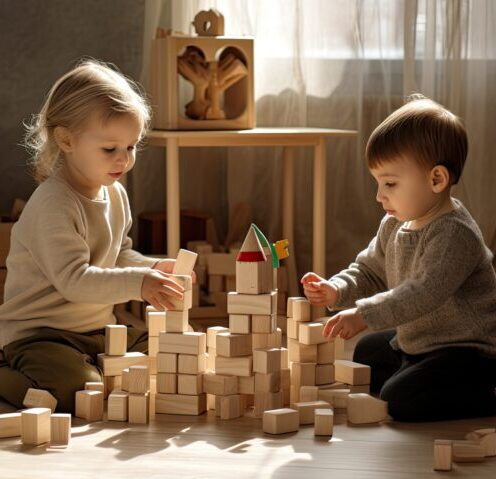Countless toys talk or beep or flash. But don’t forget to make time and room for blocks! Blocks are open-ended play materials that stimulate the imagination. They support learning in language, math, science, and art. Unlike toys that children quickly outgrow, blocks continue to be valuable learning tools for children as their play becomes more complex.
Children go through stages of block play.
- At first, children may carry blocks around and stack them randomly. Next come simple structures, such as towers and rows. Children move on to making bridges, enclosures, and buildings.
- Eventually, children use structures in dramatic play. You might see them use wooden blocks to build a pretend stove to prepare a dinner or use large cardboard blocks to build a car that they drive to work.
Block play encourages physical, social, emotional, and cognitive growth.
- Stacking and fitting blocks together builds hand strength and hand-eye coordination.
- Working in groups with blocks helps develop social skills.
- Creating designs allows self-expression and a feeling of control.
- Talking about shapes and structures builds a child’s vocabulary.
- Working with blocks in sets helps develop number concepts and spatial sense.
- Planning and building help develop problem-solving skills.
Teachers can plan for block play
- Look for unit blocks—those based on proportions such as 1:2:4.
- Make sure blocks are sturdy, well made, and plentiful. Include a variety of shapes.
- Include ramps, wheels, and pulleys to explore physics concepts.
- Create a block area away from other classroom traffic and large enough for several children.
- Work with children on simple rules: “Blocks should not be thrown.” “Blocks should be put back in the appropriate containers.”
- Store blocks on child-sized shelves to encourage independent use and clean up.
Teachers can help children extend their block play.
- Introduce new words, such as arch. Discuss place words, such as over, under, right, and left.
- Place paper and drawing tools where children can make signs for their buildings. Help children record their block work in sketches, in photographs, or on graphs.
- If children want to build a particular structure, such as a fire station, provide a photograph for them to use as a reference.
- Provide props for pretend play, such as empty food containers, costumes, or a steering wheel.
- Teach number concepts with blocks. Have children use sets of blocks, compare blocks, and divide blocks equally between them. Store blocks of similar shape together. Let children measure with rulers or string.
- Provide toy animals and plants so structures can become animal homes. Provide books on animal habitats for research.
IEL Resource
- Resource List: Block Play


 PDF
PDF